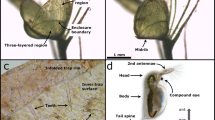Summary
The catching-net of P. conspersa larva was studies with particular reference to: structure, building, larval activity inside it and its function in prey catching.
The microscopic and macroscopic structure of this catching-net is similar to that Neureclipsis larvae, with an open-ended tunnel and two funnel shaped openings, but its shape is less regular.
The building of this net lasts about four to six hours. After a wandering period, the larva first builds the open-ended tunnel and the two openings.
Most of the time, the larva lives inside the open-ended tunnel, but it can also crawl into the entrances. Its activity does seem to be related to a diel periodicity.
During the catching process, the chief function of the net is detection, after which the prey is taken in the same way as in a spider's web.
Similar content being viewed by others
Literature
Alm, G.: Beiträge zur Kenntnis der netzspinnenden Trichopterenlarven in Schweden. Int. Rev. ges. Hydrobiol. Hydrogr. 88, 233–275 (1926).
Berland, L.: Les Arachnides. Paris: Lechevalier 1932.
Brickenstein, C.: Über den Netzbau der Larve von Neureclipsis bimaculata L. (Trichoptera, Polycentropidae). Abh. bayer. Akad. Wiss., math.-phys. Kl. 69, 1–44 (1955).
Denis, C.: Contribution à l'étude du comportement constructeur des larves de Trichoptères et problèmes relatifs à l'édification du fourreau. Rennes: Thèse Sciences 1968.
Edington, J. M.: Habitat preferences in net-spinning caddis larvae with special reference to the influence of water velocity. J. anim. Ecol. 37, 675–692 (1968).
Eliott, J. M.: The life histories and drifting of Trichoptera in a Dartmoor stream. J. anim. Ecol. 37, 615–625 (1968).
Esben-Petersen, P.: Om planctonfangende, fangnetspinnende Hydropsychidlarver i Danmark. Vidensk. Meddr. dansku naturn. Foren. 64, 282–300 (1907).
Fraisse, R.: La sécrétion de la soie chez les Invertébrés 2° thèse non publiée 1958.
Hubault, E.: Recherches sur la structure intime des étuis des larves de certains Trichoptères. Ann. Biol. lacustre. 13, 99–105 (1924).
Kloot, W. G. van der, Williams, C. M.: Cocoon construction by the Cecropia silkworm: I. The role of the external environnement. Behaviour 5, 141–157 (1953).
Le Guelte, L.: Répercussions de la perte de pattes sur la construction de la toile chez Araneus diadematus et Zygiella x notata (Araignées, Argiopidae). Psychologie Francaise 10, 259–264 (1965).
Lesperon, L.: Recherches cytologiques et expérimentales sur la sécrétion de la soie et sur certains mécanismes excréteurs chez les Insectes. Arch. zool. exp. gen. 79, 1–156 (1937).
Liesenfeld, F. J.: Untersuchungen am Netz und über den Erschütterungssinn von Zygiella x notata. Z. vergl. Physiol. 38, 563–592 (1956).
Marstaller, R.: Experimentelle und histologische Untersuchungen über die Steuerung des Köcherbaus bei Trichopteren. Zool. Jb. 75, 76–98 (1969).
Merill, D.: The stimulus for case-building activity in caddis worms (Trichoptera). J. exp. Zool. 158, 123–131 (1965).
Parry, D. A.: The signal generated by an insect in a spider's web. J. exp. Biol. 43, 185–192 (1965).
Peters, H. M.: Untersuchungen über die Proportionierung im Spinnennetz. Z. Naturforsch. 6, 90–107 (1951).
Read, C. F., Witt, P. N., Jones, R. L.: The measuring function of the first legs of Araneus diadematus Cl. Behaviour 25, 98–119 (1965).
Ross, H. H.: Evolution of caddisworm cases and nets. Amer. Zool. 4, 209–220 (1964).
Sattler, W.: Beiträge zur Kenntnis von Lebensweise und Körperbau der Larve und Puppe von Hydropsyche Pict. (Trichoptera) mit besonderer Berücksichtigung des Netzbaues. Z. Morph. Ökol. Tiere 47, 115–192 (1958).
Szlep, R.: The web-spinning process and web-structure of Latrodectus tredecimguttatus, L. Pallidus and L. Revivensis. Proc. zool. Soc. Lond. 145, 75–89 (1965).
Tachet, H.: Aspects descriptifs du comportement alimentaire chez la larve de Plectrocnemia conspersa (Trichoptera, Polycentropodidae). Z. Tierpsychol. 28, 175–184 (1971).
Wesenberg-Lund, C. J.: Biologische Studien über netzspinnende Campodeoide, Trichopterenlarven. Int. Rev. ges. Hydrobiol. Hydrogr. 3, 1–64 (1911).
Author information
Authors and Affiliations
Rights and permissions
About this article
Cite this article
Tachet, H. Le filet-piège de la larve de Plectrocnemia conspersa (Trichopteres, Polycentropodidae). Oecologia 8, 78–92 (1971). https://doi.org/10.1007/BF00345628
Received:
Issue Date:
DOI: https://doi.org/10.1007/BF00345628




